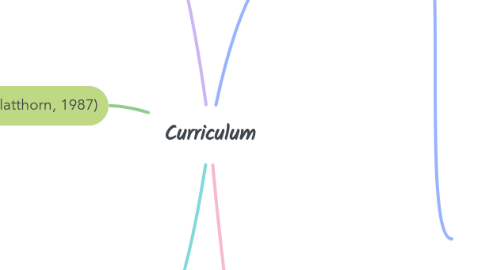
1. A plan for providing sets of learning opportunities for persons to be educated
1.1. Saylor, Alexander, and Lewis,1981, p. 10.
2. Foundations
2.1. Philosophical
2.1.1. Philosophy is central to curriculum. The philosophy of a particular school and its officials influences the goals, content, and organization of its curriculum.
2.1.1.1. Idealism
2.1.1.1.1. Spiritual, moral, or mental; unchanging
2.1.1.2. Realism
2.1.1.2.1. Based on natural laws; objective and composed of matter
2.1.1.3. Pragmatism
2.1.1.3.1. Interaction of individual with environment; always changing
2.1.1.4. Existencialism
2.1.1.4.1. Knowledge for personal choice
2.2. Socio-historical
2.2.1. Societal needs and values influence curriculum
2.2.2. The Birth of the Field of Curriculum: 1918–1949
2.2.3. Historical trends
2.2.3.1. Roots of education
2.2.3.2. 19th Century European Educators
2.2.3.3. The Rise of Universal Education: 1820–1900
2.2.3.4. Current focus
2.3. Psychological
2.3.1. Basis for understanding the teaching and learning process
2.3.1.1. How people learn
2.3.1.1.1. Learning theories
2.3.1.1.2. Students needs, motivation, engagement.
3. Types (Glatthorn, 1987)
3.1. Recommended curriculum
3.1.1. Delineated by scholars and professional organizations
3.2. Written curriculum
3.2.1. Appears in state and school district documents
3.3. Taught curriculum
3.3.1. Teachers attempt to implement
3.4. Supported curriculum
3.4.1. Helps implement or deliver the curriculum resources
3.5. Assessed curriculum
3.5.1. Tested and evaluated
3.6. Learned curriculum
3.6.1. What the students actually learn
3.7. Hidden curriculum
3.7.1. Unintended curriculum
4. Design (Ornstein & Hunkins, 2017)
4.1. Learner-Centered
4.1.1. Child’s interests and needs
4.2. Subject-Centered
4.2.1. Separate subjects
4.3. Problem-Centered
4.3.1. Focus on society and its problems
